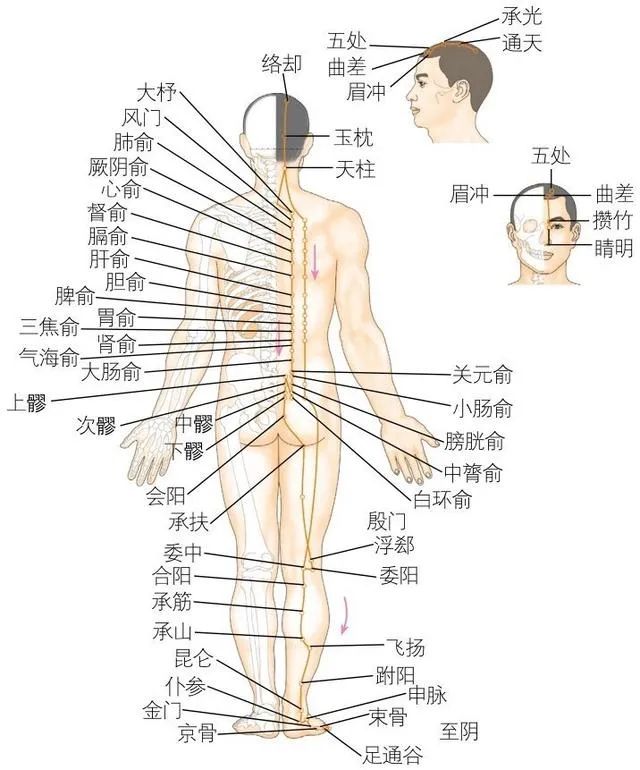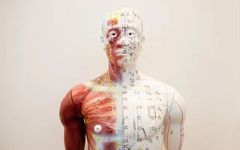The twelve meridians are the main components of the meridian system, each associated with specific organs. The acupoints are special locations where the qi and blood of the body’s organs and meridians are infused, and they are also the primary sites for acupuncture therapy. The acupoints are distributed mainly along the twelve meridians and the Ren (Conception) and Du (Governing) meridians.
Acupoints serve to infuse the organs with qi and blood, connecting the surface of the body with the internal organs. Therefore, in clinical practice, acupoints can also be used for diagnosing diseases and treating conditions. By stimulating the corresponding acupoints through acupuncture therapy, one can unblock the meridians and achieve therapeutic effects.
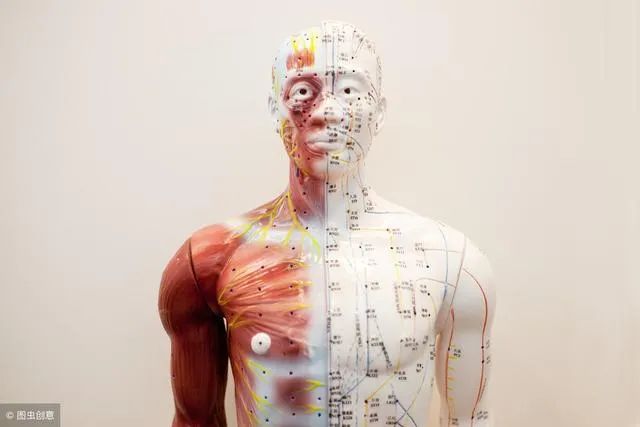
Today, we will provide a detailed explanation of the twelve major meridians in the meridian system!
1. Hand Taiyin Lung Meridian (Shou Taiyin Fei Jing)
This meridian originates from the middle jiao, connects downward to the large intestine, then returns along the stomach’s upper opening, penetrating the diaphragm, and enters the lung. It traverses horizontally from the throat, exits above the chest wall, moves towards the armpit, follows the inner edge of the upper arm, reaches the elbow, and descends along the radial side of the forearm to the wrist, then continues along the outer edge of the thenar to the radial side of the thumb. Its branch emerges above the radial styloid process of the wrist, traverses the back of the hand to the radial side of the index finger.
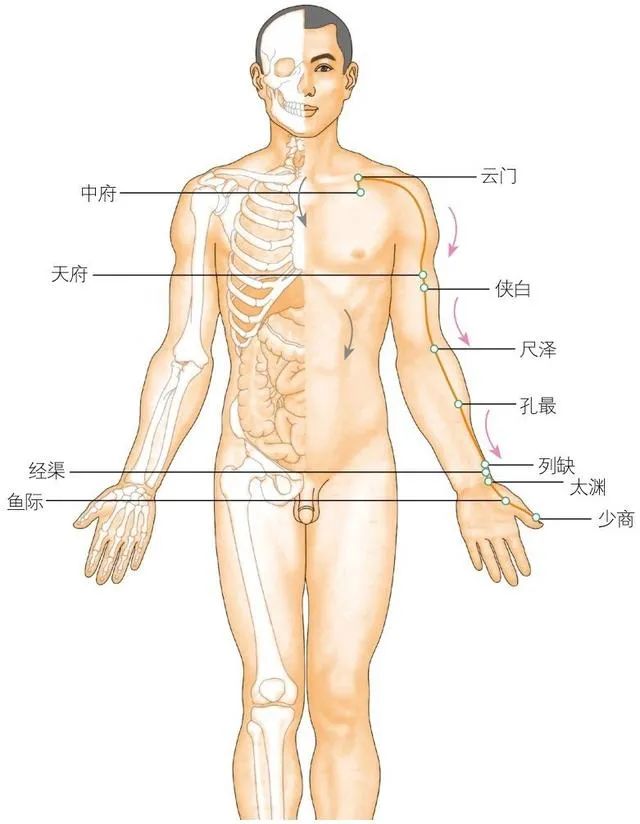

2. Hand Jueyin Pericardium Meridian (Shou Jueyin Xinbao Jing)
This meridian originates in the chest, exits the pericardium, and descends through the diaphragm, connecting to the upper, middle, and lower jiao. Its branches emerge from the chest, exit at the Tianchi (Heavenly Pool) acupoint in the lateral chest, ascend to the armpit, follow the inner midline of the upper limb to the elbow, pass the wrist, enter the palm, and travel along the radial side of the middle finger to the tip at the Zhongchong (Middle Rushing) acupoint. Another branch emerges from the palm, travels along the ulnar side of the ring finger, and connects with the Guanchong (Pass of the Gate) acupoint, linking to the Hand Shaoyang Sanjiao Meridian.
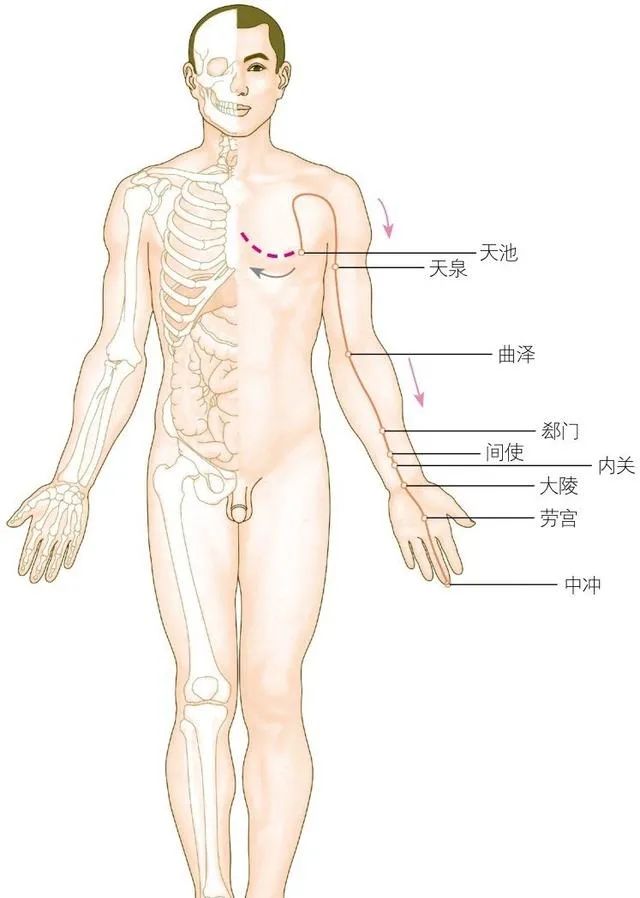

3. Hand Shaoyin Heart Meridian (Shou Shaoyin Xin Jing)
This meridian originates from the heart, exits the heart system, and the internal main trunk descends through the diaphragm, connecting to the small intestine. The external main trunk emerges from the heart system to the lung, obliquely exiting the armpit, following the inner edge of the upper arm, passing the elbow, traversing the back of the hand, entering the palm, and moving along the radial side of the little finger to the tip, connecting with the Shaochong (Lesser Rushing) acupoint, linking to the Hand Taiyang Small Intestine Meridian. Its branch ascends from the heart system, flanking the throat, connecting to the eye system, and linking to the brain’s vessels.
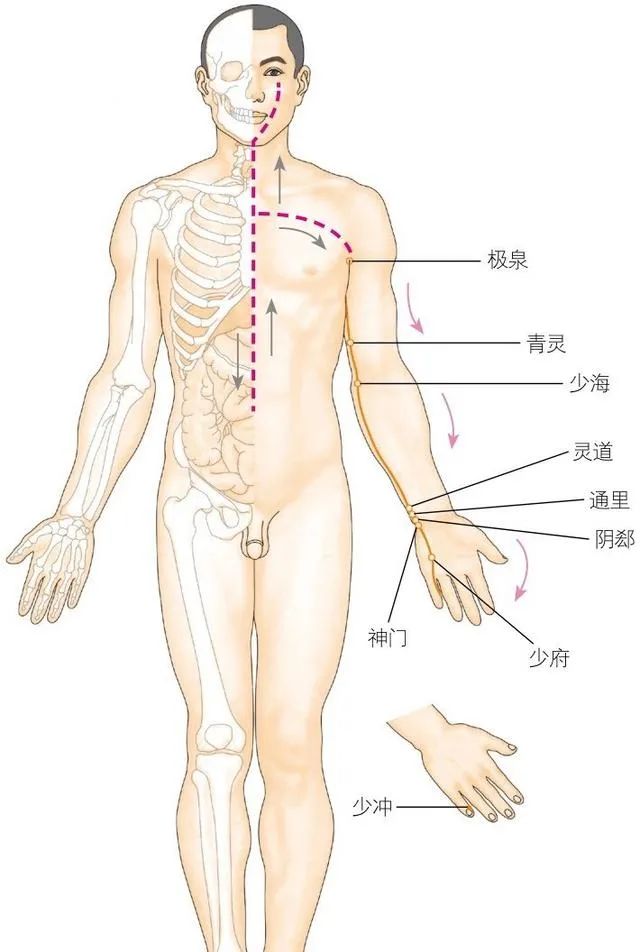

4. Hand Yangming Large Intestine Meridian (Shou Yangming Dachang Jing)
This meridian originates from the radial side of the index finger, traverses the back of the hand, moves along the outer edge of the upper limb, reaches the shoulder, and meets the Du Meridian at the Dazhui (Great Vertebra) acupoint, then descends into the supraclavicular fossa, enters the thoracic cavity, connects to the lung, passes through the diaphragm, and enters the large intestine. Its branch ascends from the supraclavicular fossa, travels through the neck to the cheek, enters the lower teeth, and returns to the sides of the mouth, crossing at the Renzhong (Human Center) groove, reaching the opposite side of the nostrils, connecting with the Yingxiang (Welcome Fragrance) acupoint, linking to the Foot Yangming Stomach Meridian.


5. Hand Shaoyang Sanjiao Meridian (Shou Shaoyang Sanjiao Jing)
This meridian originates from the ulnar side of the ring finger, ascends between the fourth and fifth fingers, travels along the back of the hand to the wrist, ascends between the ulna and radius, passes the elbow, and moves along the outer side of the upper arm to the shoulder, meeting the Du Meridian at the Dazhui acupoint. It then enters the supraclavicular fossa, spreads between the breasts, disperses qi to connect with the pericardium, and descends through the diaphragm. Its branch emerges from the chest, ascends to the supraclavicular fossa, travels up the neck, connects behind the ear, and curves above the ear to the lower eye corner. Another branch enters the ear, exits in front of the ear, passes through the Shangguan (Upper Pass) acupoint, and crosses at the cheek to the outer canthus of the eye.
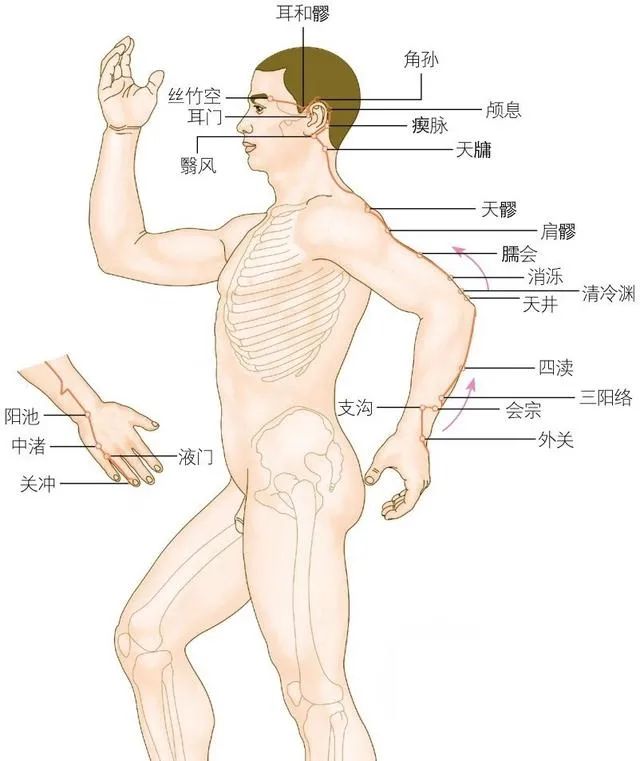

6. Hand Taiyang Small Intestine Meridian (Shou Taiyang Xiaochang Jing)
This meridian originates from the ulnar side of the little finger, ascends along the ulnar side of the palm, exits the ulnar styloid process, travels along the back of the forearm, ascends between the ulnar olecranon and the medial epicondyle of the humerus, follows the outer edge of the upper arm to the shoulder joint, and meets the Du Meridian at the Dazhui acupoint. It then enters the supraclavicular fossa, penetrates the thoracic cavity, connects to the heart, descends along the esophagus, passes through the diaphragm, reaches the stomach, and enters the small intestine. Its branch emerges from the supraclavicular fossa, travels up the neck to the outer corner of the eye, and returns to enter the ear. Another branch emerges from the cheek, travels under the eye, reaches the inner corner of the nose, and then obliquely moves to the zygomatic area. The qi from this meridian connects with the Foot Taiyang Bladder Meridian.
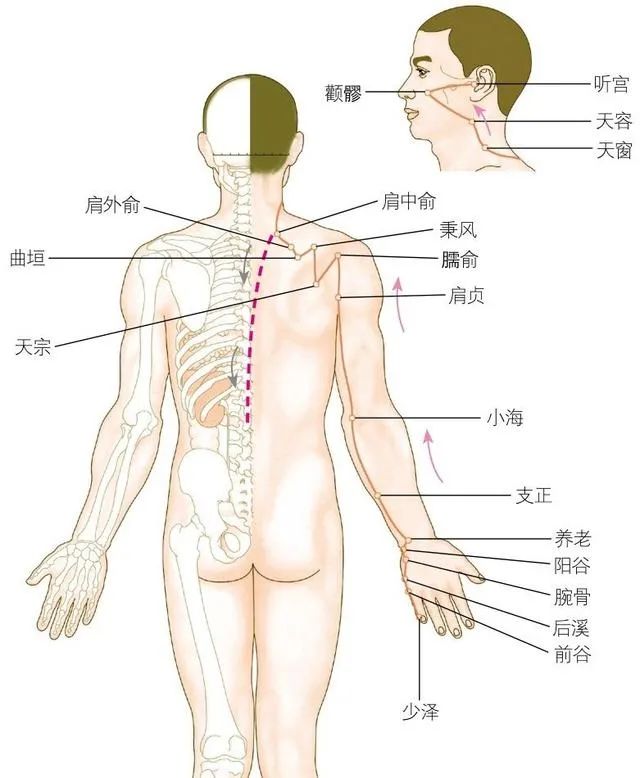

7. Foot Taiyin Spleen Meridian (Zu Taiyin Pi Jing)
This meridian originates from the inner side of the big toe, travels along the inner side of the foot, ascends over the anterior edge of the inner ankle, moves up the inner side of the leg along the midline, crosses 8 cun above the inner ankle, intersects with the Foot Jueyin Liver Meridian, ascends along the inner edge of the thigh, enters the abdomen, belongs to the spleen, connects to the stomach, ascends through the diaphragm, and travels alongside the esophagus, connecting to the root of the tongue and dispersing under the tongue. This meridian’s branch emerges from the stomach, ascends through the diaphragm, enters the Daba (Great Package) acupoint, and connects with the Hand Shaoyin Heart Meridian.
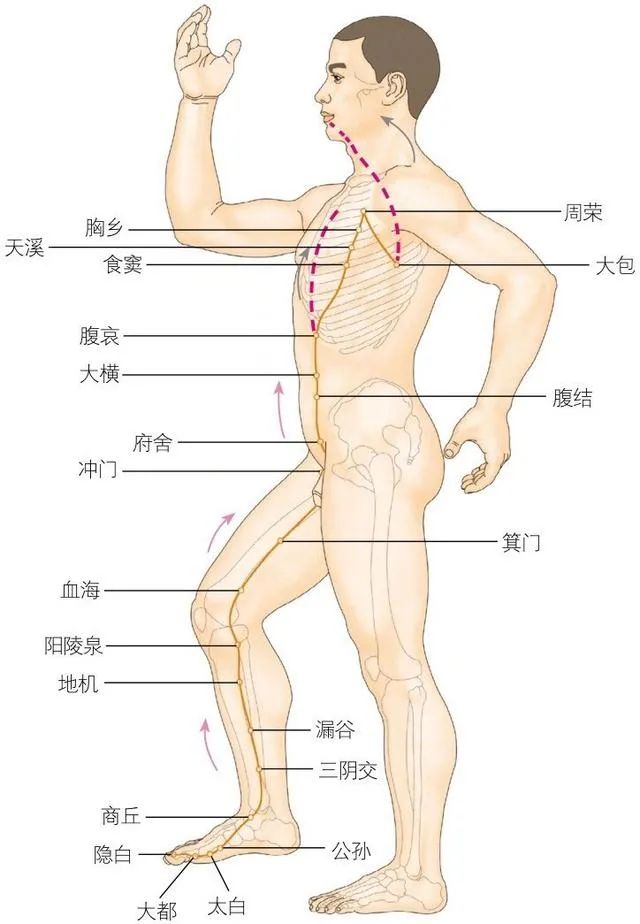

8. Foot Jueyin Liver Meridian (Zu Jueyin Gan Jing)
This meridian originates from the back of the toenail of the big toe, ascends along the foot’s dorsum to 1 cun in front of the inner ankle, ascends along the inner edge of the tibia, intersects with the Foot Taiyin Spleen Meridian at 8 cun above the inner ankle, ascends along the inner side of the knee, follows the midline of the inner thigh, enters the pubic area, encircles the genitals, reaches the lower abdomen, flanks the stomach, belongs to the liver, connects to the gallbladder, ascends through the diaphragm, spreads in the lateral rib area, travels along the back of the throat, ascends into the nasopharynx, and connects to the eye system, exiting at the forehead, where it meets the Du Meridian at the top of the head. One branch emerges from the eye system, descends along the cheek, and encircles the inside of the lips. Another branch emerges from the liver, passes through the diaphragm, ascends into the lung, and connects with the Hand Taiyin Lung Meridian.
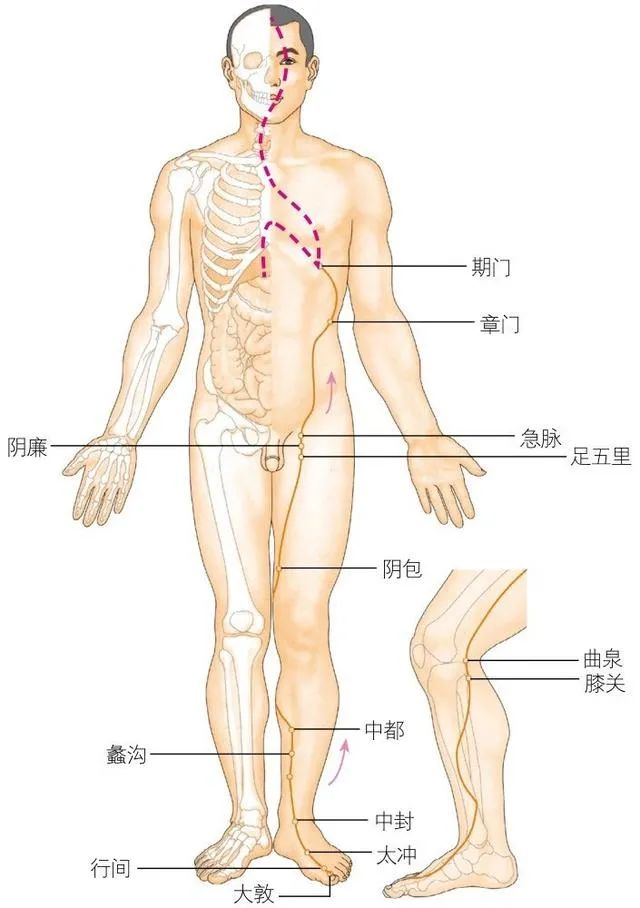

9. Foot Shaoyin Kidney Meridian (Zu Shaoyin Shen Jing)
This meridian originates from beneath the little toe, travels diagonally across the sole of the foot, exits beneath the tuberosity of the navicular bone, follows the posterior edge of the inner ankle, enters the heel, ascends along the posterior edge of the inner leg, reaches the medial side of the popliteal fossa, ascends along the posterior edge of the inner thigh, penetrates the spine, belongs to the kidney, and connects to the bladder. This meridian travels directly within the abdominal cavity, ascends from the kidney, passes through the liver and diaphragm, enters the lung, and travels along the throat to the sides of the root of the tongue. One branch emerges from the lung, connects to the heart, and enters the chest, linking to the Hand Jueyin Pericardium Meridian.


10. Foot Yangming Stomach Meridian (Zu Yangming Wei Jing)
This meridian originates from beside the nostrils, ascends along the nose, crosses at the root of the nose, enters the inner canthus of the eye, intersects with the Foot Taiyang Bladder Meridian, descends along the outer side of the nasal column, enters the upper teeth, returns to the sides of the mouth, encircles the lips, and crosses at the Chengjiang (Receiving Fluid) acupoint, returning along the lower jaw’s posterior edge to the Daying (Great Welcome) acupoint, ascending along the jaw angle, passing in front of the ear, traversing the Shangguan acupoint, and reaching the forehead.
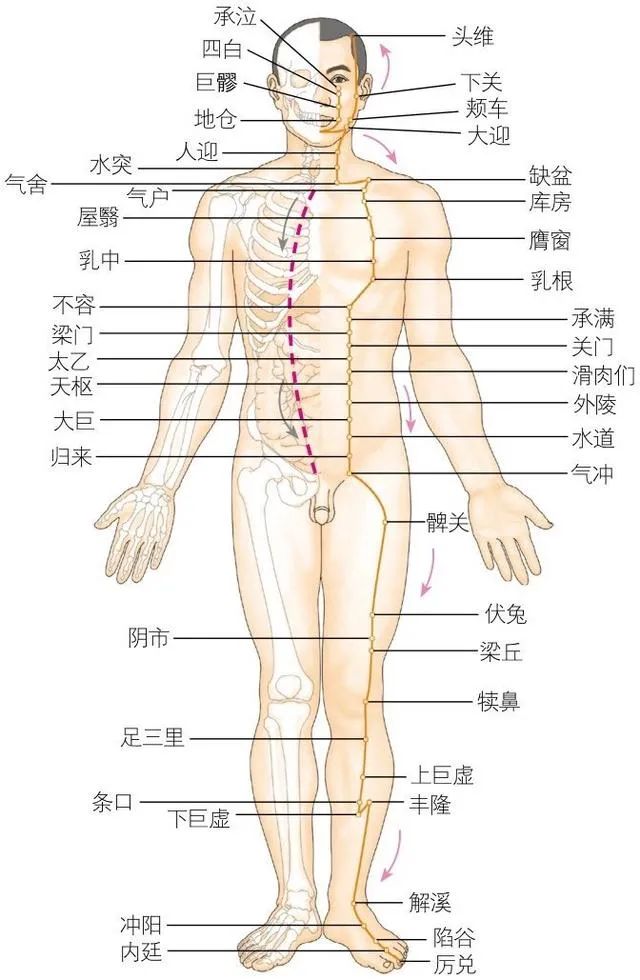

11. Foot Shaoyang Gallbladder Meridian (Zu Shaoyang Dan Jing)
This meridian originates from the outer corner of the eye, ascends to the forehead, descends behind the ear, travels down the neck, through the shoulder, and enters the supraclavicular fossa. The main channel continues from the supraclavicular fossa to the armpit, travels along the lateral side of the chest and abdomen, meets the branch from the outer corner of the eye at the hip joint, and then descends along the outer midline of the lower limb, passing in front of the outer ankle, and travels along the dorsum of the foot to the outer side of the fourth toe.
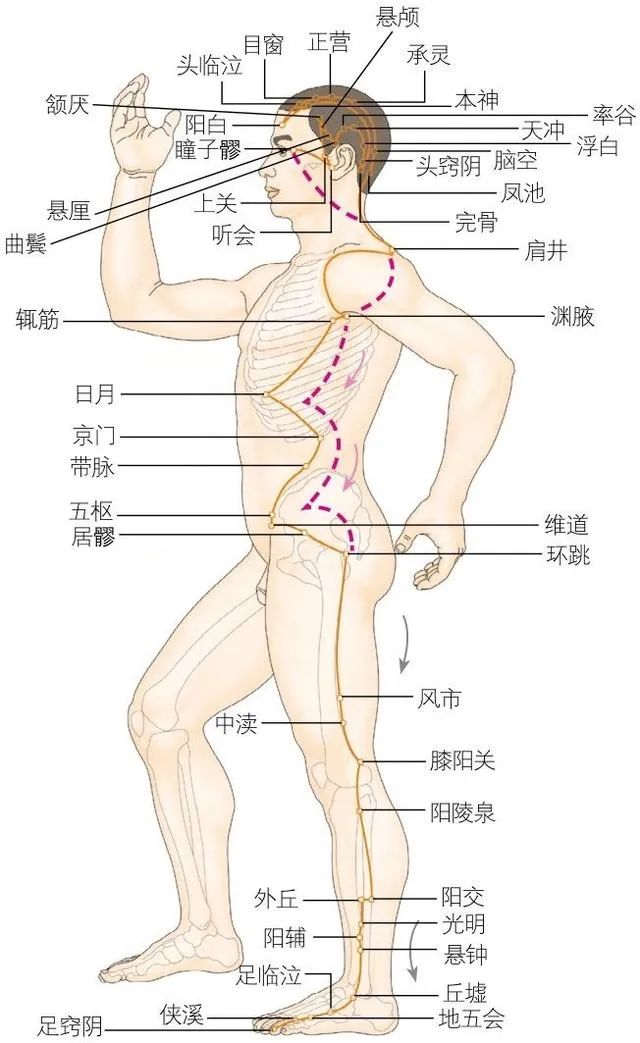

12. Foot Taiyang Bladder Meridian (Zu Taiyang Pangguang Jing)
This meridian originates from the inner canthus of the eye, ascends to the forehead, and meets at the top of the head. Its branches emerge from the top of the head, reaching the upper corner of the ear. The main channel continues from the top of the head, traveling backward to the occipital bone, entering the cranial cavity, connecting to the brain, and descending to the nape, where it meets at the Dazhui acupoint, then branches left and right along the inner side of the scapula, flanking the spine, reaching the lumbar region, entering the muscles beside the spine, penetrating the abdominal cavity, connecting to the kidney, and belonging to the bladder. One branch emerges from the lumbar region, descends along the sides of the spine, passes through the buttocks, and descends along the posterior edge of the thigh to the popliteal fossa. Another branch emerges from the nape, descends along the inner side of the scapula, travels down to the Huantiao (Jumping Circle) acupoint, and continues along the posterior side of the thigh to the popliteal fossa, where it meets the previous branch, then descends through the gastrocnemius muscle, exiting behind the outer ankle, and travels along the outer edge of the foot to the outer side of the little toe, connecting with the Foot Shaoyin Kidney Meridian.
